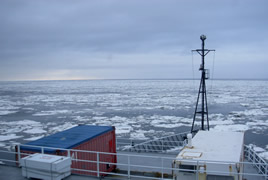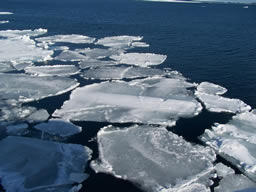 |
Ship in sea ice in the Bering Sea. Frequent winter storms break up and move ice. Photo: P.Sullivan, UW/JISAO and EcoFOCI . |
The presence of sea
ice has a substantial influence on the physical properties
(temperature, salinity) of the water even months after the ice has disappeared. The dissolved salts in
sea water are not incorporated into sea ice as it forms. Thus, when sea ice forms, saltier water is left
behind under the ice. This salty water is denser than the surrounding water and sinks. On the other hand,
melting ice introduces fresher water to the surface of the ocean. Ice floes move with the wind and the
currents. In the Bering Sea, ice is usually formed in the northern part of the sea, and carried southward
by the prevailing wind. As the sea ice moves southward into warmer water, it melts along its edges.
 |
Bering Sea ice on a rare sunny day. Photo: C. Ladd, NOAA/PMEL |
We measure the physical water
properties (temperature, salinity) of both the ice and the water close to
the ice edge. Combined with observations made by other scientists on this expedition, these
measurements help us determine how the seawater is affected by the presence of sea ice and what
water types are preferred by the plants and animals in the region. We also measure the amount
of light penetration into the water and through the ice to determine how much light is available for
plant photosynthesis. And we measure the speed and direction of the currents in the region.
In addition to measuring the physical conditions on this expedition,
we hope to continue making these measurements over the coming years to examine
changes in the system from year to year.
|





